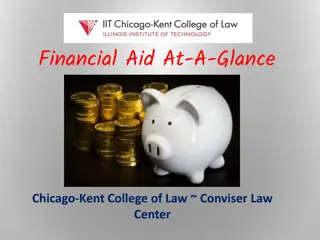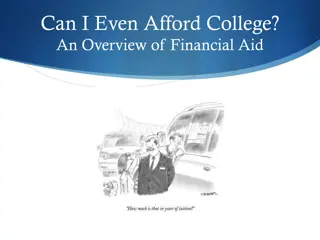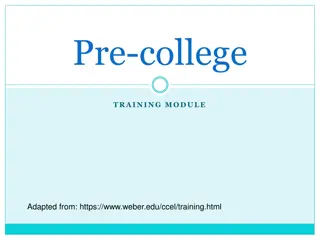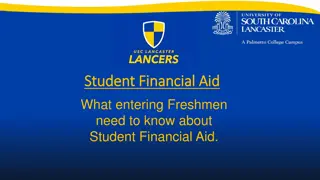Understanding College Financial Aid - A Comprehensive Guide
Explore the key aspects of financing your college education, including financial aid, eligibility criteria, types of assistance available, cost of attendance, and the student aid index. Discover valuable insights on how to manage and secure funding for your higher education journey.
Download Presentation

Please find below an Image/Link to download the presentation.
The content on the website is provided AS IS for your information and personal use only. It may not be sold, licensed, or shared on other websites without obtaining consent from the author. Download presentation by click this link. If you encounter any issues during the download, it is possible that the publisher has removed the file from their server.
E N D
Presentation Transcript
FINANCING YOUR COLLEGE EDUCATION Presenters: Rosemarie Lynch & Yhony De Paz
Agenda What is Financial Aid? What is Financial Need? Who is Eligible? Types of Financial Aid FAFSA New York State Aid Programs Scholarship & Additional Resources Conclusion
What is Financial Aid? Financial Aid = money provided to students to help pay for post-secondary educational expenses Need-based Money given because student has need: Grants (free money) Scholarships (free money) Loans (money that must be paid back) Merit-based Scholarships given because of skills such as: Academics Athletics
What is Financial Need? COA = direct + indirect costs SAI = Student Aid Index Calculated using data from the FAFSA and a federal formula Other Financial Assistance (OFA) Cost of Attendance (COA) Student Aid Index (SAI) Financial Need
Cost of Attendance (COA) Direct Costs: tuition, required fees, room, meals, books & supplies Indirect Costs: transportation, miscellaneous personal expenses, study abroad expenses, dependent care expenses, disability-related expenses COA = direct + indirect costs Varies widely from college to college
Student Aid Index = SAI SAI appears on the FAFSA Submission Summary The index reflects an evaluation of a student's approximate financial resources to contribute towards the student's education for the academic year. This number is used to determine your eligibility for need-based federal student aid. Starting in the 2024-2025 FAFSA this number could be a negative value.
Who is Eligible? General Eligibility for Student Aid Have a high school diploma or its equivalent Be enrolled or accepted for enrollment as a regular student working towards a degree OR certificate in an eligible program Be a U.S. citizen or eligible non-citizen for federal aid (i.e. permanent resident/political asylum) Transfer students must be in good Financial Aid standing with your loans Resident of New York state for state aid Enrolled as a full-time student taking 12 or more credits (applicable toward your degree program) per semester for New York state aid Students must be in good academic standing for both federal & state aid
Dependency Status If a student meets any of the following criteria, they are considered Independent for Aid Eligibility: Foster Care (ages 13 or older) Orphan/Ward of the Court A student with both parents deceased If orphaned by 13 or older and subsequently adopted, student is considered independent Court has assumed legal custody of a student, not due to incarceration Legal Guardianship In all cases, documentation is required. These students may qualify for the Federal Pell and NYS Grants.
Types of Loans Loans for Students* Direct Subsidized Loans (need-based) 1st Year = $3,500, 2nd Year = $4,500, 3rd/4th Years = $5,500 Interest is not required to be paid while you are enrolled for at least half time. Direct Unsubsidized Loans (not need-based) 1st Year = $5,500, 2nd Year = $6,500, 3rd/4th Years = $7,500 Interest is accrued the moment the loan has pay out. *Loan amounts based on a dependent status Loans for Parents PLUS Loans (must meet credit standards) Amount = COA Student s Financial Need Parents are responsible for repayment (begins 60 days after last disbursement)
Types of Grants Federal Grants (Annual) Pell Grant: up to $7,395 (6-year limit) Federal Supplemental Educational Opportunity Grant (FSEOG): $100 to $4,000 Federal Work-Study: Students are placed in jobs on or off-campus New York State Grants (Annual) Tuition Assistance Program (TAP): $500 to $5,665 4-year limit (no more than 8 full-time semesters) Part-time TAP (PTAP) 6-11 credits Aid for Part-Time Study (APTS): 3 11 credits Special program (SEEK 10 semesters)
Free Application for Federal Student Aid (FAFSA) A standard form that collects demographic and financial information about the student and family Required for all types of federal aid Apply and reapply each year (English & Spanish) Available December 31, 2023 the earlier you apply, the better chance you have at receiving different type of federal grants Queens College Code: 002690
FAFSA on the Web www.fafsa.gov Students, spouses and parents must have Access to an FSA ID This includes undocumented parents and spouses Apply for FAFSA Check status of application View your FAFSA Submission Summary Make corrections
FAFSA on the Web (contd) Import most U.S. income and tax information to the 2024-2025 FAFSA by utilizing the Future Act Direct Data Exchange (FA-DDX) . Eliminates the need for most applicants (spouse & parents) to self-report their income and tax information reported to the IRS. Students, spouses, and parents, will be required to consent and approve to the new data transfer for federal student aid eligibility. Even if the applicant is aware they did not file a federal tax return. Foreign earned income will be entered manually.
New York State Aid Programs Tuition Assistance Program (TAP) Available to NY State residents attending a college or university in NY State To Apply for TAP You should complete the FAFSA and TAP application Once you complete the FAFSA application, it will ask you if you want to start your state application to apply for New York state-based financial aid www.hesc.ny.gov Queens College Code : 1416
Apply for TAP and Other NYS Financial Aid Available to NYS residents attending a College or University in NY State. There are 2 pathways to filling out the TAP application. (FAFSA & DREAM Act)
Jose Peralta NYS DREAM Act NYSDREAM Act allows undocumented and other eligible students to apply for one or more New York State aid, such as, TAP and Excelsior Scholarship. Not required to complete the FAFSA application. The requirements are: - High school attendance - High school completion - In-state SUNY or CUNY tuition - Citizenship or immigration status Step-by-Step User Guide to completing the DREAM Act application is on the HESC website https://www.hesc.ny.gov/dream (User guide are available in English, Spanish, Traditional Chinese & Korean)
Excelsior Scholarship The Excelsior Scholarship, in combination with other student financial aid programs, allows students to attend a SUNY or CUNY college tuition-free. A recipient of an Excelsior Scholarship may receive up to $5,500 for the academic year. An applicant must: Graduated from high school in the United States or earned a high school equivalency diploma; Have a combined federal adjusted gross income of $125,000 or less; Pursue an undergraduate degree at a SUNY or CUNY college; Be enrolled in at least 12 credits per term and complete at least 30 credits each year Be on track to graduate on time with an Associate's Degree in two years or a Bachelor's Degree in four years; The application will be available through the HESC website. Please check their website periodically for availability.
Scholarship Resources For a list of reputable scholarship searches, go to: BigFuture https://bigfuture.collegeboard.org/scholarship-search Scholarships for NYC and NYS students www.hesc.ny.gov (Grant, Scholarships & Loan Programs) Fastweb background and profile) www.fastweb.com (Scholarships and fellowships are identified based on Dream US Scholarship www.thedream.us (scholarships are for highly motivated undocumented students who are unable to afford the cost) United Negro College Fund - www.uncf.org (UNCF offers several national and regional scholarships and job opportunities.
Additional Resources On-Demand Virtual Events What seniors need to know about financial aid for College UFT College & Career Fair College Financial Aid for Veterans and Dependents Creating your FSA ID https://startheregetthere.ny.gov/events Fact Sheets Reference guides on how to pay for College Guide to planning for College and more https://www.hesc.ny.gov/hesc-fact-sheets.html
Conclusion Do not wait until you are admitted to file the FAFSA Apply to colleges by earliest possible deadline Complete all questions accurately You must RE-apply for FAFSA/ TAP each year Know your school s priority and deadline dates Keep copies of all documents for your records Beware of scams - Filing for FAFSA is FREE Check your email used on all applications: They communicate to the students first before colleges
How to Contact Us Fresh Service (Perspective and Current Students) Cloud-based service desk that allows students to submit their financial aid inquiries and get status updates in a timely manner. https://support.qc.cuny.edu Navigate (Current Students) Current students can schedule an online/virtual appointment with a financial aid advisor. https://www.qc.cuny.edu/navigate/























